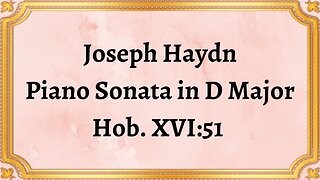Premium Only Content

Franz Joseph Haydn Piano Concerto No11 in D major
#classicalmusic #musicalcomposition #orchestralmusic #pianist #Haydn #PianoConcerto #Dmajor #MusicAppreciation #musiceducation
Franz Joseph Haydn's Piano Concerto No. 11 in D major is a stunning piece of classical music. It was composed by Haydn towards the end of his life in the year 1784. The piece is an excellent example of the Classical Era's keyboard concerto and is regarded as one of the most virtuoso concertos written by Haydn.
The Piano Concerto No. 11 in D major follows the traditional three-movement structure, where the soloist interacts with the orchestra. The first movement, Vivace, is a lively musical piece that showcases the virtuosity of the pianist. It starts with an orchestral introduction, and then the piano enters with joyous and speedy motifs that alternate with more lyrical, melancholic ideas.
The second movement, Un poco adagio, is a beautiful and delicate composition with a slow and expressive melody that showcases Haydn's poetic side. The piece has a lyrical and melancholic tone, and the soloist dominates the sad and sentimental motifs of the piano. The orchestra accompanies, with soft and delicate textures, emphasizing the harmonic richness of the piece.
The final movement, Rondo all'Ungarese, is a cheerful and lively closing piece. It features Hungarian folk music's rhythmic influences, which Haydn ingeniously amalgamates with Classical Era structures. The orchestra and the piano engage in dialogues that incorporate stylistic elements of Hungarian gypsy bands, such as virtuosic runs and trills.
Haydn's Piano Concerto No. 11 in D major showcases the interplay between the piano and the orchestra, with the orchestra offering a beautiful background to highlight the skills of the pianist. The concerto is considered highly challenging for the soloist, as it requires virtuosity, technical skill, and artistic maturity.
One of the most notable features of the Piano Concerto No. 11 in D major is its harmonic structure. Haydn uses harmonic modulations that suggest a freer approach to the Classical Era's rigid forms. The piano's demanding virtuosity and the orchestra's harmonic sophistication create an intriguing blend of classical structures infused with musical lyricality and romantic sentimentality.
In conclusion, Piano Concerto No. 11 in D major is a stunning piece of music that showcases the virtuosity, harmonic sophistication, and compositional skills of Haydn. Its engagement with classical structures and Hungarian folk influences not only demonstrates the great compositional skill Haydn possessed, but also highlights the influence of history and context on music
You have the opportunity to support the channel https://destream.net/live/RadSiarAl/donate
-
 6:07
6:07
Classical music_Music Inspiration
27 days agoJoseph Haydn Piano Sonata in D Major, Hob. XVI:51
771 -
 4:04:20
4:04:20
Nerdrotic
5 hours ago $33.88 earnedAmazon Takes 007! Hollywood is Lost, Disney Cancels WHO? | Friday Night Tights 342 /w ItsAGundam
112K23 -
 43:27
43:27
Tucker Carlson
4 hours agoRay Dalio: America’s Hidden Civil War, and the Race to Beat China in Tech, Economics, and Academia
100K122 -
 56:56
56:56
Candace Show Podcast
5 hours agoEXCLUSIVE: Taylor Swift Will Be Deposed. | Candace Ep 150
91.2K98 -
 1:03:52
1:03:52
IsaacButterfield
2 hours ago $0.26 earnedRepublican Vs 25 Transgender Activists | Jewish Outrage | Lizzo Loses All the Weight
8.3K1 -
 DVR
DVR
Edge of Wonder
6 hours agoChinese Biochips Hacking Minds? Quantum Control & Journey Song Mandela Effect
13.7K3 -
 LIVE
LIVE
Quite Frankly
9 hours ago"Ghosts, Robotics, and OBE's" ft. Dr. Albert Taylor 2/21/25
898 watching -
 55:52
55:52
LFA TV
1 day agoMaking Germany Great Again | TRUMPET DAILY 2.21.25 7PM
19.9K1 -
 1:52:26
1:52:26
2 MIKES LIVE
4 hours ago2 MIKES LIVE #183 Open Mike Friday with Hannah Faulkner and Adelia Kirchner!
13.7K -
 12:09
12:09
MrBigKid
4 hours ago $1.65 earnedNew Mossberg 590R: Tactical Homestead Defender
24.4K5